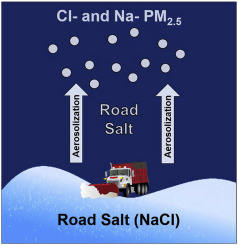One of Air Sciences’ senior scientists, Dr. Katheryn Kolesar, recently published an article in Atmospheric Environment, with colleagues from the University of Michigan’s Pratt Lab, examining particulate formation due to road salt applications.

During the winter, many areas of the United States (and Europe) apply granular salt (primarily NaCl) to the roads in an effort to clear the roads of snow and ice. Dr. Kolesar and colleagues used data from the United States Environmental Protection Agency (EPA) Chemical Speciation Network (CSN) to assess temporal trends of sodium and chloride PM2.5 at 25 locations across the United States to investigate the ubiquity of road salt aerosols.
The study links the application of road salt to an increase in sodium and chloride in inhalable particulate matter (PM < 2.5 μm), thus demonstrating that road salt particles become aerosolized. In coastal areas, fresh sea spray aerosol, which is rich in chloride, is known to increase ozone concentrations in urban, coastal environments. Since fresh road salt aerosol is also rich in chloride, there is a possibility that its application leads to increased wintertime ozone concentrations. To further understand the influence of road salt application on wintertime ozone chemistry, it will be important to develop emission factors so that emission inventories such as the National Emissions Inventory (NEI) can include the influence of road salt on PM.
Nice work, Katie!
Link to article: https://doi.org/10.1016/j.atmosenv.2018.01.008
